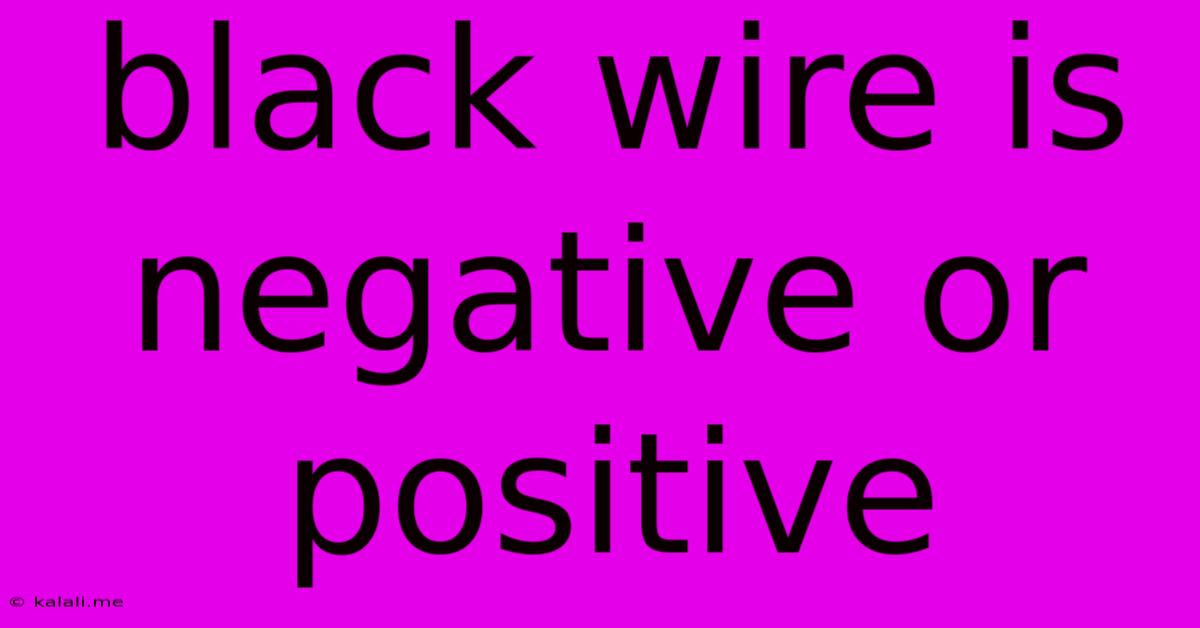Black Wire Is Negative Or Positive
Kalali
Jun 07, 2025 · 3 min read

Table of Contents
Black Wire: Negative or Positive? Understanding Electrical Wiring Conventions
Determining whether a black wire is positive or negative depends entirely on the context. There's no universal rule stating black always represents one or the other. This article will clarify the nuances of electrical wiring conventions and help you understand how to identify polarity in different applications. Understanding this is crucial for safe and effective electrical work.
The Confusion Around Black Wire Color Codes
The color of wires in electrical systems is used to indicate their function within a circuit. However, these color codes aren't entirely standardized across all applications. This is the primary source of confusion regarding the black wire.
Where Black Typically Means Negative:
- Audio Equipment: In many audio applications, such as speakers and microphones, black typically indicates the negative or ground terminal. This convention is widely observed and helps technicians quickly identify the appropriate connections. This is particularly important to prevent short circuits and maintain audio signal integrity.
- Low Voltage DC Systems: In low-voltage DC systems, like those found in automotive applications or some electronics, black frequently signifies the negative terminal. This is a common practice for consistency and safety. Checking your vehicle's wiring diagram is always recommended before working on any electrical components.
Where Black Typically Means Positive:
- 120V AC Household Wiring (North America): In standard North American household wiring, black is typically the hot wire carrying 120V AC. The white wire is the neutral, and the bare copper or green wire is the ground. This is a crucial distinction and incorrectly connecting wires in this system can lead to electric shock and fire hazards.
- Other AC Systems: The designation of black as positive (or hot) in AC systems isn't limited to North American households. Many international standards may also use black for the live or hot conductor. Always refer to local electrical codes and wiring diagrams for clarification.
Why the Variation Exists:
The lack of universal standardization stems from historical practices and the evolution of electrical systems. Different industries and regions have adopted varying conventions over time. This makes careful observation and documentation critical for every electrical project.
How to Determine Polarity in Any Situation:
Never rely solely on wire color. Always use a multimeter to verify the voltage and polarity of any wire before connecting it. This is a vital safety precaution that can prevent injury and damage to equipment.
Here's how to use a multimeter:
- Set your multimeter to the appropriate voltage setting (DC or AC, depending on the system).
- Connect the positive lead (red) of the multimeter to the wire in question.
- Connect the negative lead (black) of the multimeter to a known ground or negative point in the circuit.
- Observe the reading. A positive reading indicates a positive wire (or hot wire in AC systems), while a negative reading indicates a negative wire (or neutral/ground).
Conclusion:
The color of a wire is just a visual guide, not a definitive indicator of its polarity. Always verify polarity using a multimeter before working with any electrical system, regardless of wire color. Understanding wiring conventions and safety procedures are essential for anyone working with electricity. Remember to consult local electrical codes and diagrams for specific applications and always prioritize safety.
Latest Posts
Latest Posts
-
Will Polarized Sunglasses Work For Solar Eclipse
Jun 07, 2025
-
Points That Lie In The Same Plane
Jun 07, 2025
-
Fleas Are Gone But Cat Wont Go On Carpet
Jun 07, 2025
-
Tv Show People Seeing Weird Numbers
Jun 07, 2025
-
How Do You Wire A 3 Way Dimmer Switch
Jun 07, 2025
Related Post
Thank you for visiting our website which covers about Black Wire Is Negative Or Positive . We hope the information provided has been useful to you. Feel free to contact us if you have any questions or need further assistance. See you next time and don't miss to bookmark.